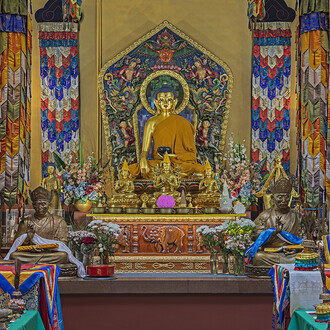The exhibition of Italian art of the 16th-18th centuries on the first floor in the New Hermitage occupies the so- called Small and Large Italian Skylight Halls (rooms 237-238), the rooms of the Courtyard enfilade, “the Italian Cabinets” (rooms 230-236) and the Italian Majolica Room (room 229).
Two early paintings by Raphael - “The Conestabile Madonna” and “The Holy Family” – as well as the enormous cartoon by Giulio Romano entitled ”The Triumph of Scipio the African”are displayed in room 229.On view here are also objects of decorative and applied art of the Renaissance Age,including 16th-century examples of majolica, cassones and tapestries. The Courtyard enfiladeopens with the room of frescoes created in the 16th century by artists of the Raphaelite school on the subjects from "Metamorphoses”by Ovid. Also here is a small-scale sculptureby Michelangelo Buonarroti entitled the “Crouching Boy”, which was acquired for the imperial collection by order of Catherine II.Besides “The Italian Cabinets” contain part of Farsetti’s collection of sculptures and the works by the great master of the Baroque style Gian Lorenzo Bernini.
The Bologna Academy is represented by the paintings by the Carracci brothers, Guido Reni, Guercino and Domenichino (rooms 237,231).Another division of the collection known as Italian Caravaggism (rooms 237,232,233) is represented by “The Lute Player” (room 237), the only painting in Russia by Michelangelo Merisi da Caravaggio. The Large Italian Skylight Hall displays large-scale canvases byItalian artists of the 17th and 18th centuries (room 238). Exhibited here are the paintings in the genre of the veduta, the works by the leading Italian Baroque artist Luca Giordano, as well as the paintings by Salvator Rosa and Giovanni Maria Crespi. Large-scale decorative canvases painted by Tiepolo on themes from ancient Roman history were created by the master for the Dolphino Palace in Venice. In the centre of the room stands the sculpture entitled “The Death of Adonis” by Giuseppe Mazzuola.
















